AI at Work
How to Use AI SEO Content Generator for Better Ranking Content

Akshita Sharma · Content Marketing Associate
April 3rd, 2025 · 11 min read

While marketers initially approached AI SEO content generators with skepticism, the technology has rapidly matured beyond basic keyword optimization. IDC predicts that by 2026, generative AI will take over the heavy lifting of several routine SEO tasks. Typeface, for instance, can analyze top-ranking content across your target keywords, extract winning semantic patterns, and help your team consistently produce content that matches search intent while maintaining your brand's editorial standards. Forward-thinking businesses using AI for SEO are already seeing the results—65% better search performance and 68% higher returns on their content investments. For teams managing high-volume content operations, these figures translate to significant competitive advantages.
This guide provides a framework for enterprise content leaders to implement AI-augmented SEO strategies and allow their teams to reallocate resources from routine tasks to high-value strategic initiatives to dominate the search.
What is an AI SEO content generator?
How to use AI SEO content generator for marketing content
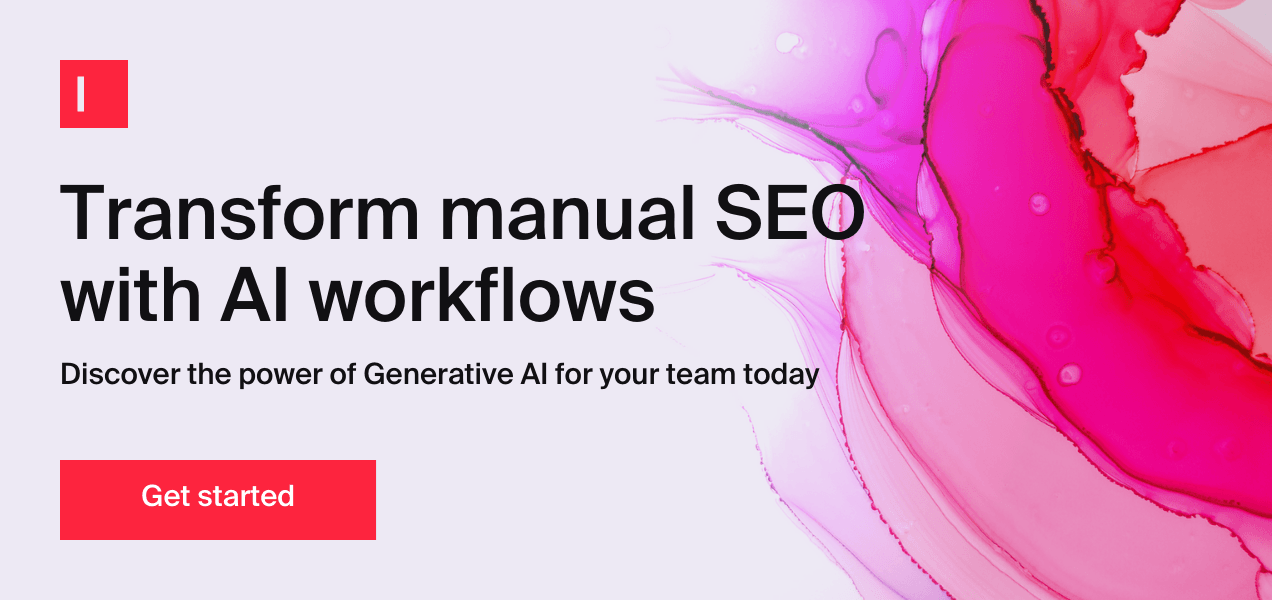
What is an AI SEO content generator?
An AI SEO content generator is simply a tool that uses artificial intelligence to create search-optimized content that drives organic traffic. Unlike basic text generators, this AI SEO tool analyzes top-performing content, search intent, and ranking signals to identify patterns that lead to higher rankings. It then uses this data to optimize new content, ensuring it meets the criteria set by search engines, regarding keyword placement, content structure, and readability.
By automating the labor-intensive components of SEO content development, AI SEO content generators help content teams redirect valuable resources from manual keyword research and content optimization to higher-value strategic initiatives. For enterprise marketers, using AI for SEO can reduce production timelines from weeks to hours while improving content quality to meet search engine and audience standards.
How Typeface solves common SEO challenges
Marketing teams today face a unique challenge. They aren't seeking to merely replicate what's already ranking—a strategy that increasingly falls flat as Google's algorithm evolves and places a great focus on promoting helpful, reliable, and people-first content. What they want is a sophisticated approach to SEO content creation that simultaneously strengthens brand authority and captures search visibility. That is precisely what Typeface offers.
Our end-to-end SEO workflow transforms what traditionally requires weeks of fragmented effort across multiple teams into a streamlined process. It provides everything, from competitive research to AI SEO content generation to optimization, all within a single workflow. What's more, the platform learns from your brand voice, audience segments, and proprietary data, which allows for scalable SEO content production without compromising your unique brand voice and identity.
Here's how Typeface addresses some common SEO content development challenges:
The challenge: SEO teams often need to juggle multiple tools to analyze competitor pages and gather keywords and traffic data. This scattered approach wastes time and makes it difficult for teams to identify the patterns essential for ranking success.
The solution: Typeface eliminates the need to switch between different tools by combining Google Insights, Semrush analytics, and on-brand content creation in one place. It even allows direct publishing with built-in connectors.
The challenge: Gathering PAA insights often involves manually searching through platforms like Quora, Reddit, and Google to find relevant questions your audiences are asking. This can be time-consuming.
The solution: Typeface offers AI-powered insights to replace manual competitor research. It identifies successful content structures, ideal lengths, and important People Also Ask (PAA) questions to include in your content.
The challenge: Manual keyword research is inefficient and impractical, especially when you're creating content at scale.
The solution: Typeface's AI analyzes top-performing content related to your topic to recommend the best primary and secondary keywords, so you can focus on what matters to your audience.
The challenge: Simply identifying target keywords and stuffing them into the content isn't effective. Writers need to weave keywords naturally into the content while maintaining their unique voice and writing style.
The solution: Typeface offers SEO Blog Post template and an SEO Refresh feature to help you easily add keywords to new or existing content. Unlike basic keyword tools, our platform analyzes the semantic context of your existing content, identifies optimal placement opportunities, and intelligently integrates target keywords while preserving your established brand voice parameters and subject matter authority.
The challenge: To publish confidently, marketers need to know how their content measures up against the competition. Text analysis tools can help, but many of these tools usually don't include competitor insights.
The solution: The Content Explainability feature on Typeface provides performance scores, improvement tips, and feedback specifically for your brand, audience, and channel. It also includes an SEO scoring system that evaluates your blog posts based on factors like word count and keyword use.
Now, let's explore how Typeface can assist you in crafting high-quality, user-focused content while also enhancing it for search.
How to use AI SEO content generator to rank better
1. Using AI for keyword research
An AI SEO content generator can streamline keyword research by offering smart keyword suggestions that save you both time and effort. These tools leverage machine learning algorithms to find topic-relevant keywords, decode key metrics such as search intent, and rank them to help you rank on search.
When you feed a seed keyword or topic on Typeface, the platform doesn't just return basic variations—it creates semantic clusters that include both primary and secondary keywords, including long-tail phrases your competitors likely overlooked. The platform allows you to select keywords that seem most relevant to you, or you can add your own custom keywords. Primary keywords get highlighted in titles and headers during content generation, while secondary keywords are woven into the main content.
💡 Quick tip: Choose 1-2 primary keywords and 4-5 secondary ones.
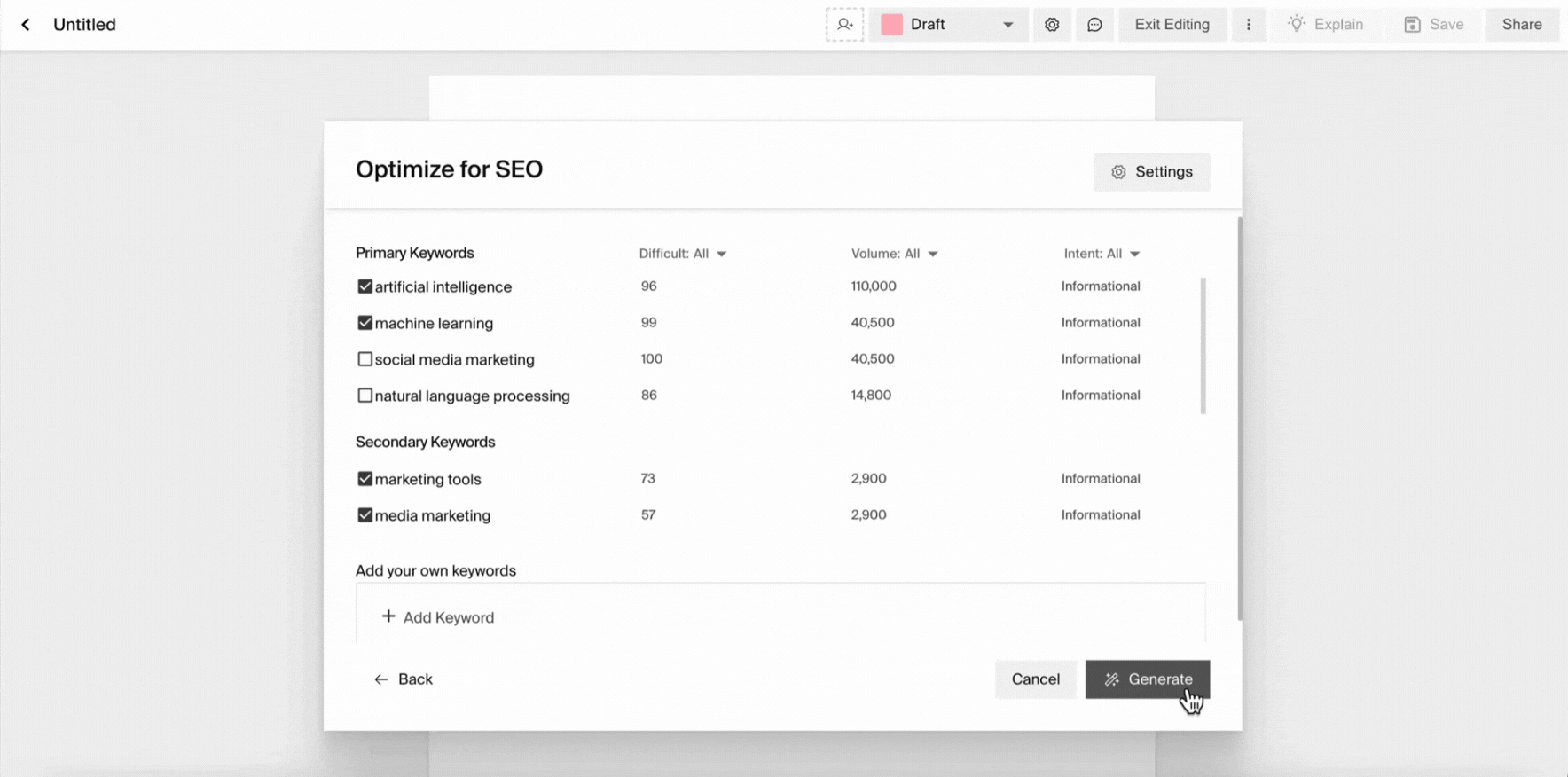
For marketers managing complex content ecosystems across multiple product lines, this capability uncovers micro-market opportunities that traditional keyword tools miss entirely.
2. Creating SEO content outlines
One of the foundational steps in content creation is developing a solid outline. AI SEO content generators can help in this process by creating detailed and structured outlines based on your chosen topic and relevant keywords. This way, writers have a clear roadmap to follow, which ensures that the content flows smoothly and logically, and all critical points are thoroughly covered. Moreover, these outlines allow the natural integration of keywords into the content.
When you're generating a blog article on Typeface, you'll get an AI-generated outline that you can edit and refine before starting the content development.
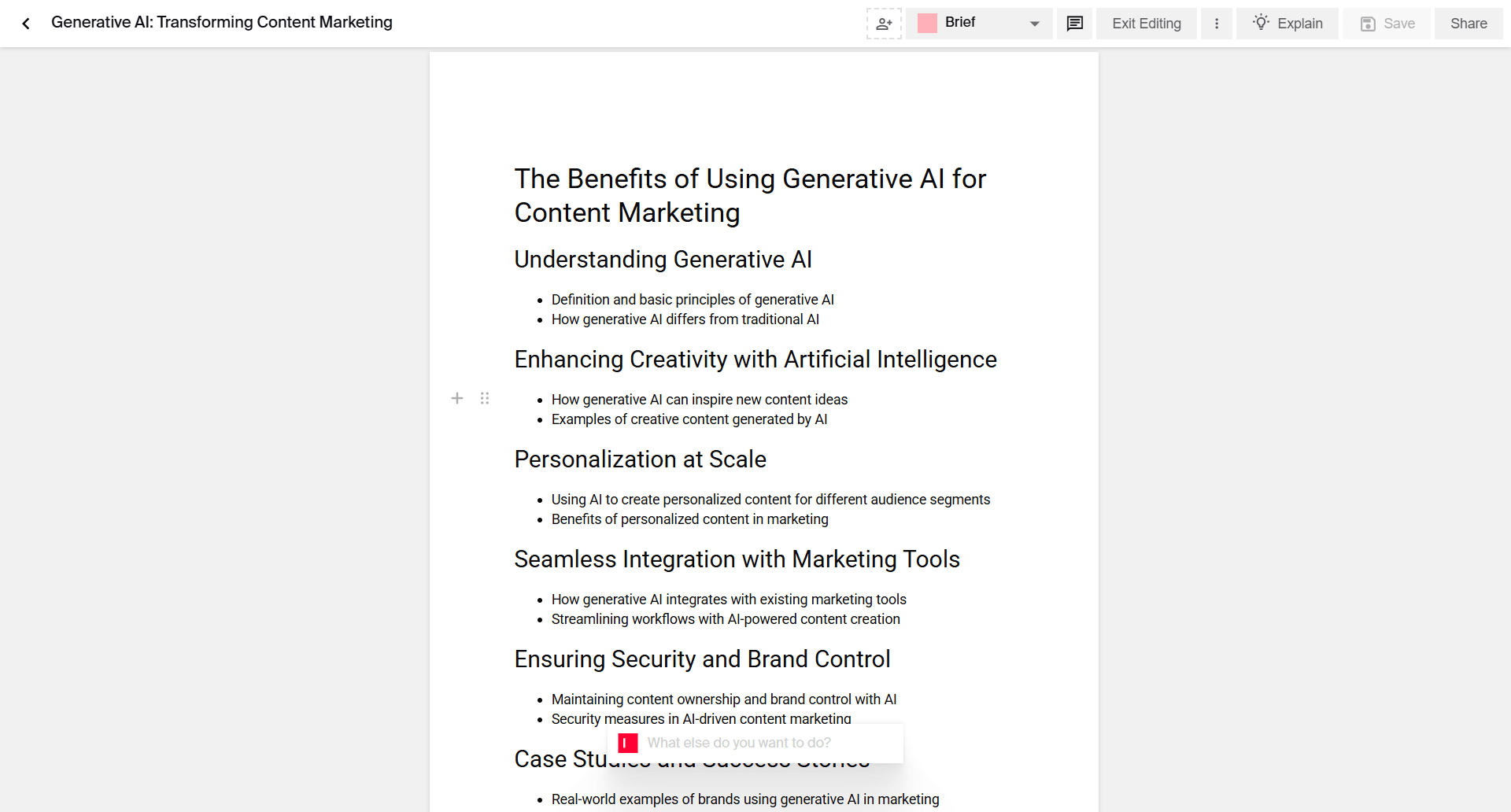
Alternatively, you can use the "Generate text" option to feed in a AI SEO prompt with your topic and target keywords to create the content outline.
The AI-generated outline can then be enhanced using competitive insights from Typeface. In the "Explain" section, you'll find links to top-performing content on your topic. This allows you to adjust the elements in your content outline and choose the best content length.
3. Creating FAQ sections
FAQ sections are valuable for both users and search engines, and AI SEO content generators can help enhance these sections by identifying common PAA questions and providing concise, accurate answers during content generation. This not only improves user experience but also increases the chances of your content appearing in featured snippets and AI overviews.
💡 Quick tip: Add the FAQ section to your blog outline before you generate the post.
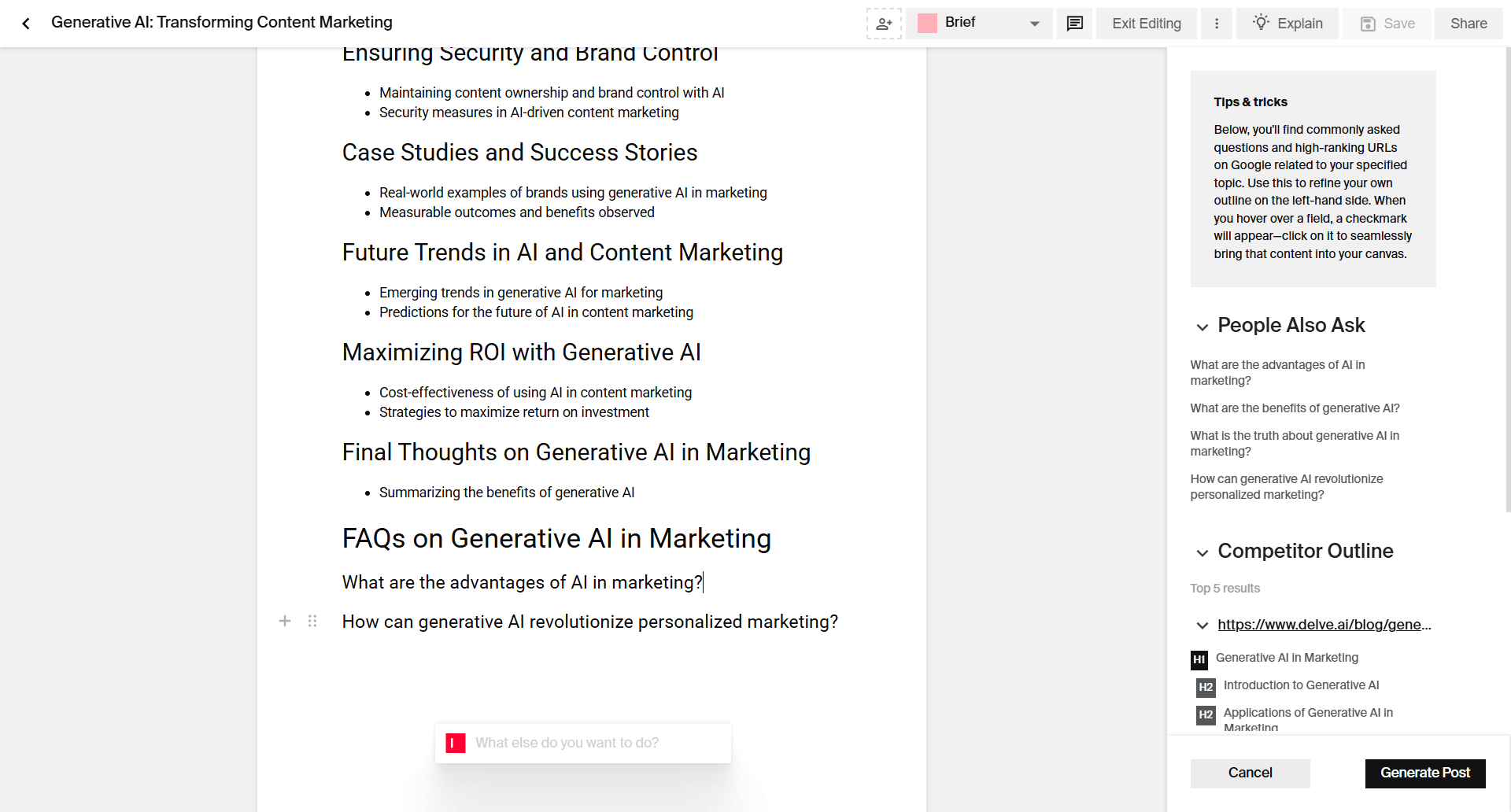
Using formatting techniques like numbered lists or bullet points can boost the chances of your content being featured in prominent search positions.
4. Generating complete SEO blogs
The blog creation process has traditionally been a resource-intensive process. When SEO enters the equation, what was already challenging becomes exponentially more complex. Typeface's generative AI platform addresses this problem by offering "SEO blog post" template that generates search-optimized first drafts in minutes. It finds geo-specific keywords, generates content outlines, and develops complete drafts that organically incorporate your targeted keywords at optimal densities.

The real value comes when your team shifts from content creation to strategic refinement—applying their expertise to enhance, personalize, and perfect content that's already substantively complete and on-brand.
5. Crafting SEO meta tags
While crafting meta titles and descriptions for a handful of pages is straightforward, this task turns into a significant resource drain when managing hundreds of blog posts, product pages, and landing pages. Most marketing teams face an inevitable dilemma: either compromise quality through rushed, generic descriptions that fail to drive engagement, or create an ever-growing backlog of unoptimized pages that represent missed conversion opportunities.
Typeface's "SEO meta tags" AI template can be used here to get a search-optimized meta title, compelling meta description, and content summary to maximize your digital visibility and drive qualified traffic.

6. Repurposing existing content for SEO
Instead of letting valuable content sit after initial publication, you can use Typeface's AI content repurposing templates to turn them into search-friendly formats. The "Document Transform" template will help you turn detailed whitepapers into blog series targeting specific keywords. The "Web Blend" template can be used to update and optimize existing web content without starting anew. The "YouTube Blend" and "Podcast Blend" templates can pull valuable insights from interviews and webinars, transforming them into SEO-focused articles that reach more people.
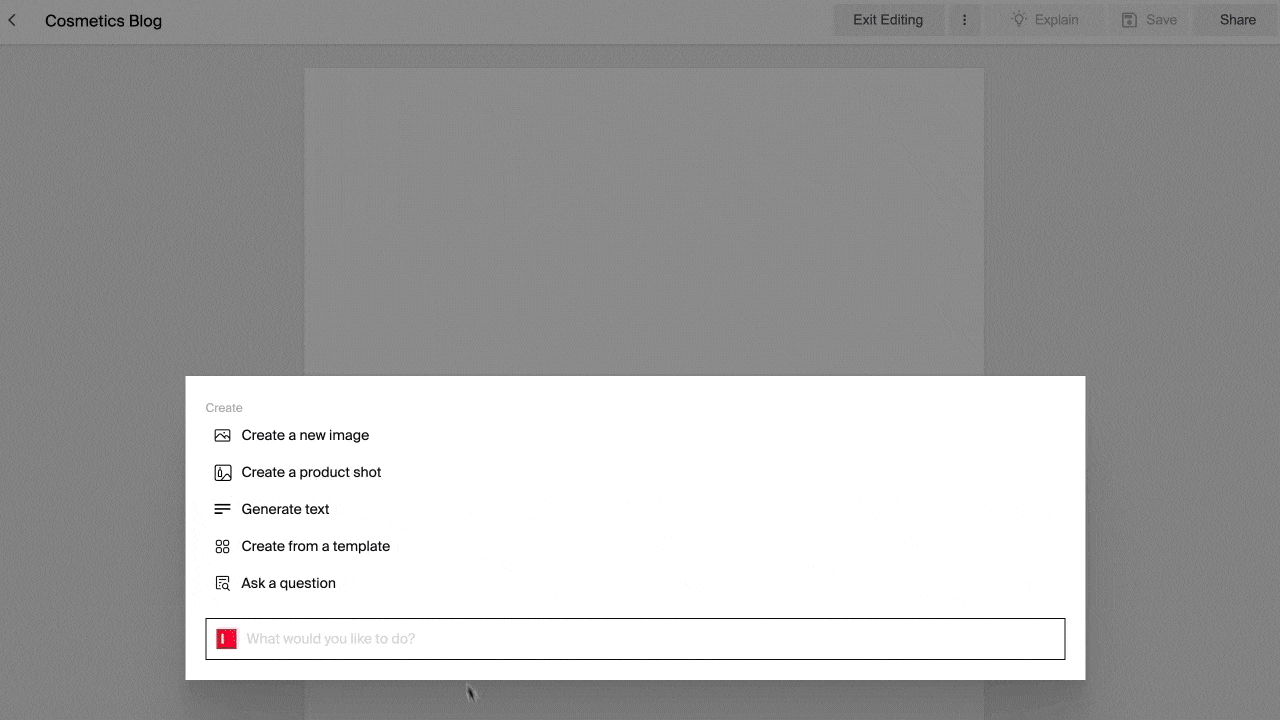
7. Improving SEO content performance with AI
Enterprise SEO teams can now leverage AI-powered analytics to pinpoint exact optimization opportunities rather than relying on intuition. Typeface's Content Explainability feature, for instance, provides granular performance metrics through a comprehensive SEO scoring system that quantifies content quality. It identifies precisely where and how often target keywords and phrases appear, enabling marketers to make strategic adjustments before publication.
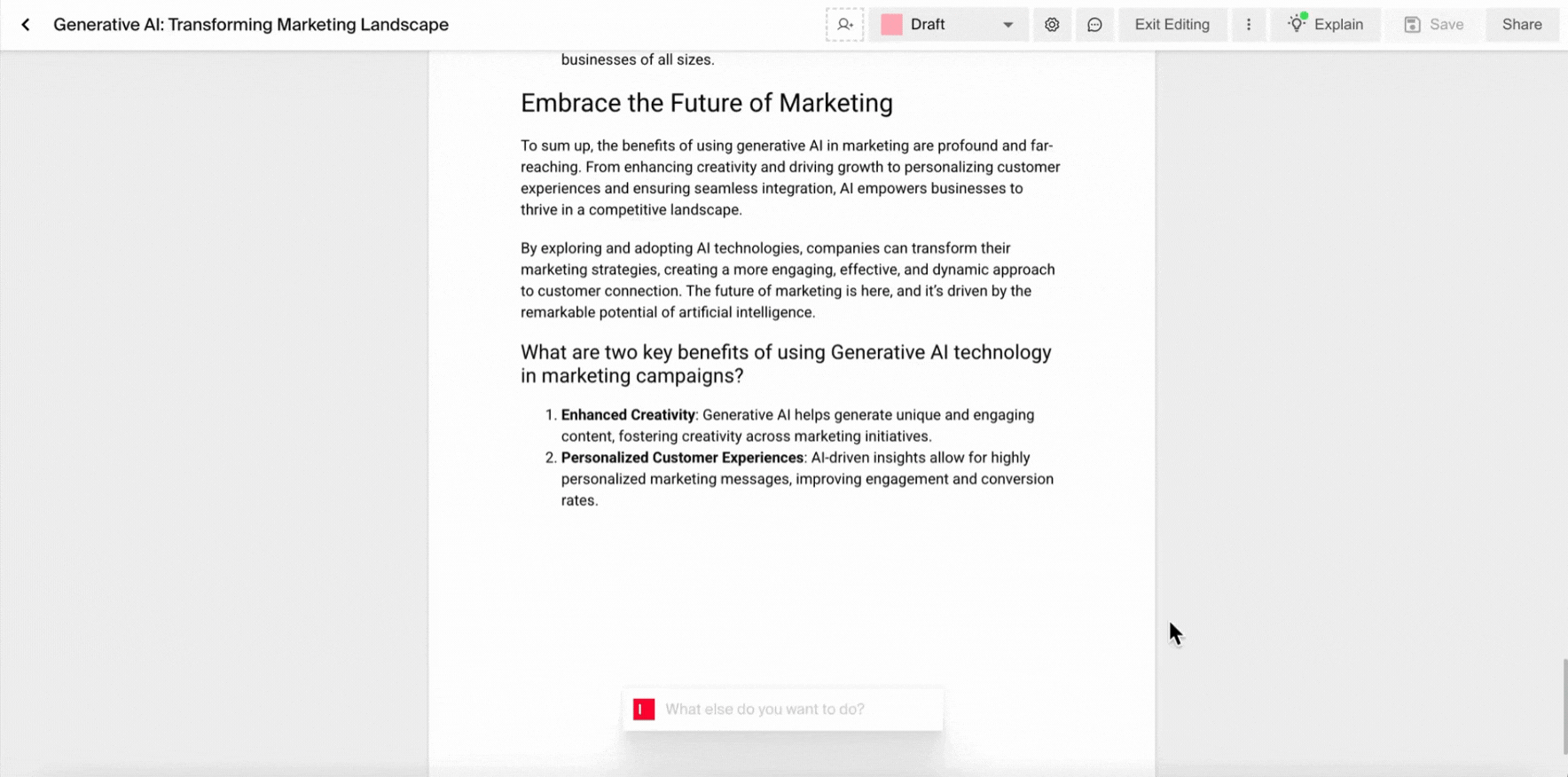
This shift from retrospective analysis to proactive optimization significantly shortens the content development cycle while increasing the likelihood of ranking improvements.
Improve your search rankings with AI
As we've demonstrated throughout this guide, an AI SEO content generator doesn't simply accelerate content production; it can streamline the complete SEO workflow. Where conventional SEO demands resource-intensive coordination between multiple teams, Typeface's enterprise-grade platform compresses weeks of fragmented effort into a streamlined, data-driven SEO workflow that delivers measurable ROI. Besides analyzing competitor patterns, Typeface seamlessly blends your unique brand voice, audience insights, and proprietary data to produce content that is both optimized for algorithms and genuinely reflects your brand.
As search algorithms move towards helpful, reliable, and people-first content, enterprises that thrive will be those leveraging AI not just for keyword optimization, but for delivering genuinely valuable content at scale and speed. That's what Typeface can help you deliver by integrating content creation and optimization right into your workflow. You can try it free for 30 days, or check out our webinar on transforming manual SEO with AI workflows to learn more.

Share
Related articles

AI at Work
40+ AI SEO Prompts for Strategy Building and Content Creation

Akshita Sharma · Content Marketing Associate
February 7th, 2025 · 14 min read

AI at Work
AI for SEO - 7 Powerful Tips to Integrate AI Into SEO Content Writing

Neelam Goswami · Content Marketing Associate
November 28th, 2024 · 12 min read
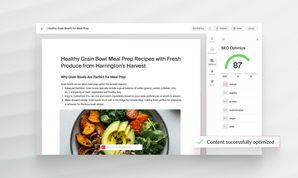
Product
Introducing a New End-to-End SEO Workflow That Scales High-Quality, User-Centric Content Production 6x Faster

Saachi Shah · Product Manager
January 29th, 2025 · 7 min read